Related Research Articles

Photometry, from Greek photo- ("light") and -metry ("measure"), is a technique used in astronomy that is concerned with measuring the flux or intensity of light radiated by astronomical objects. This light is measured through a telescope using a photometer, often made using electronic devices such as a CCD photometer or a photoelectric photometer that converts light into an electric current by the photoelectric effect. When calibrated against standard stars of known intensity and colour, photometers can measure the brightness or apparent magnitude of celestial objects.
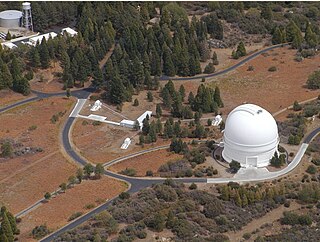
Palomar Observatory is an astronomical research observatory in San Diego County, California, United States, in the Palomar Mountain Range. It is owned and operated by the California Institute of Technology (Caltech). Research time at the observatory is granted to Caltech and its research partners, which include the Jet Propulsion Laboratory (JPL), Yale University, and the National Astronomical Observatories of China.
The Sloan Digital Sky Survey or SDSS is a major multi-spectral imaging and spectroscopic redshift survey using a dedicated 2.5-m wide-angle optical telescope at Apache Point Observatory in New Mexico, United States. The project began in 2000 and was named after the Alfred P. Sloan Foundation, which contributed significant funding.

Siding Spring Observatory near Coonabarabran, New South Wales, Australia, part of the Research School of Astronomy & Astrophysics (RSAA) at the Australian National University (ANU), incorporates the Anglo-Australian Telescope along with a collection of other telescopes owned by the Australian National University, the University of New South Wales, and other institutions. The observatory is situated 1,165 metres (3,822 ft) above sea level in the Warrumbungle National Park on Mount Woorat, also known as Siding Spring Mountain. Siding Spring Observatory is owned by the Australian National University (ANU) and is part of the Mount Stromlo and Siding Spring Observatories research school.
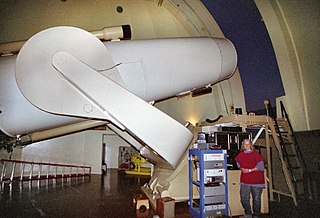
The Samuel Oschin telescope, also called the Oschin Schmidt, is a 48-inch-aperture (1.22 m) Schmidt camera at the Palomar Observatory in northern San Diego County, California. It consists of a 49.75-inch Schmidt corrector plate and a 72-inch (f/2.5) mirror. The instrument is strictly a camera; there is no provision for an eyepiece to look through it. It originally used 10- and 14-inch glass photographic plates. Since the focal plane is curved, these plates had to be preformed in a special jig before being loaded into the camera.

An astronomical survey is a general map or image of a region of the sky that lacks a specific observational target. Alternatively, an astronomical survey may comprise a set of images, spectra, or other observations of objects that share a common type or feature. Surveys are often restricted to one band of the electromagnetic spectrum due to instrumental limitations, although multiwavelength surveys can be made by using multiple detectors, each sensitive to a different bandwidth.

The Katzman Automatic Imaging Telescope (KAIT) is an automated telescope used in the search for supernovae.

The All Sky Automated Survey (ASAS) is a Polish project implemented on 7 April 1997 to do photometric monitoring of approximately 20 million stars brighter than 14 magnitude all over the sky. The automatic telescopes discovered two new comets in 2004 and 2006. The ASAS-South, located in Chile and ASAS-North, located in Hawai'i, are managed by Grzegorz Pojmański of the Warsaw University Observatory via the internet.
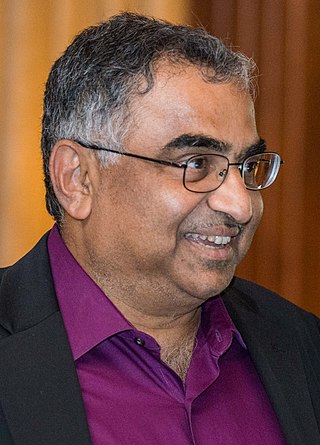
Shrinivas Ramchandra Kulkarni is a US-based astronomer born and raised in India. He is currently a professor of astronomy and planetary science at California Institute of Technology, and he served as director of Caltech Optical Observatory (COO) at California Institute of Technology, in which capacity he oversaw the Palomar and Keck among other telescopes. He is the recipient of a number of awards and honours.

9912 Donizetti, provisional designation 2078 T-3, is a stony Rafita asteroid from the central regions of the asteroid belt, approximately 7 km in diameter. It was discovered during the third Palomar–Leiden Trojan survey in 1977, and named after Italian composer Gaetano Donizetti.
4722 Agelaos is a Jupiter trojan from the Trojan camp, approximately 53 kilometers in diameter. It was discovered during the third Palomar–Leiden Trojan survey at the Palomar Observatory in California in 1977. The Jovian asteroid has a rotation period of 18.4 hours and belongs to the 90 largest Jupiter trojans. It was named after Agelaus from Greek mythology.
5010 Amenemhêt is a stony asteroid from the central region of the asteroid belt, approximately 9 kilometers in diameter.
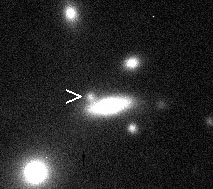
NGC 5177 is a lenticular galaxy. Based on a redshift of 6467 km/s the galaxy is crudely estimated to be about 300 million light-years away.
Image subtraction or pixel subtraction or difference imaging is an image processing technique whereby the digital numeric value of one pixel or whole image is subtracted from another image, and a new image generated from the result. This is primarily done for one of two reasons – levelling uneven sections of an image such as half an image having a shadow on it, or detecting changes between two images. This method can show things in the image that have changed position, brightness, color, or shape.
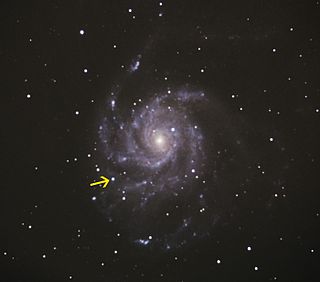
SN 2011fe, initially designated PTF 11kly, was a Type Ia supernova discovered by the Palomar Transient Factory (PTF) survey on 24 August 2011 during an automated review of images of the Messier 101 from the nights of 22 and 23 August 2011. It was located in Messier 101, the Pinwheel Galaxy, 21 million light years from Earth. It was observed by the PTF survey very near the beginning of its supernova event, when it was approximately 1 million times too dim to be visible to the naked eye. It is the youngest type Ia ever discovered. About 13 September 2011, it reached its maximum brightness of apparent magnitude +9.9 which equals an absolute magnitude of about -19, equal to 2.5 billion Suns. At +10 apparent magnitude around 5 September, SN 2011fe was visible in small telescopes. As of 30 September the supernova was at +11 apparent magnitude in the early evening sky after sunset above the northwest horizon. It had dropped to +13.7 as of 26 November 2011.

Time-domain astronomy is the study of how astronomical objects change with time. Though the study may be said to begin with Galileo's Letters on Sunspots, the term now refers especially to variable objects beyond the Solar System. Changes over time may be due to movements or changes in the object itself. Common targets included are supernovae, pulsating stars, novas, flare stars, blazars and active galactic nuclei. Visible light time domain studies include OGLE, HAT-South, PanSTARRS, SkyMapper, ASAS, WASP, CRTS, and in a near future the LSST at the Vera C. Rubin Observatory.

ULTRASAT is a space telescope in a smallsat format with a large field of view, 210 square degrees, that will detect and monitor transient astronomical events in the near-ultraviolet (220–280 nm) spectral region. ULTRASAT will observe a large patch of sky, alternating every six months between the southern and northern hemisphere. The satellite will be launched into geosynchronous orbit in early 2026. All ULTRASAT data will be transmitted to the ground in real time. Upon detection of a transient event, ULTRASAT will provide alerts within 20 minutes to other ground-based and space telescopes to be directed to the source for further observation of the event in other wavelength bands.
The All Sky Automated Survey for SuperNovae (ASAS-SN) is an automated program to search for new supernovae and other astronomical transients, headed by astronomers from the Ohio State University, including Christopher Kochanek and Krzysztof Stanek. It has 20 robotic telescopes in both the northern and southern hemispheres. It can survey the entire sky approximately once every day.
The Zwicky Transient Facility is a wide-field sky astronomical survey using a new camera attached to the Samuel Oschin Telescope at the Palomar Observatory in California, United States. Commissioned in 2018, it supersedes the (Intermediate) Palomar Transient Factory (2009–2017) that used the same observatory code. It is named after the astronomer Fritz Zwicky.
References
- ↑ Law, Nicholas M.; Kulkarni, Shrinivas R.; Dekany, Richard G.; Ofek, Eran O.; et al. (2009), "The Palomar Transient Factory: System Overview, Performance, and First Results", Publications of the Astronomical Society of the Pacific, 121 (886): 1395–1408, arXiv: 0906.5350 , Bibcode:2009PASP..121.1395L, doi:10.1086/648598, ISSN 0004-6280, S2CID 62829270
{{citation}}: CS1 maint: numeric names: authors list (link) - 1 2 "Supernova Collides With Its Companion Star". Science Daily. 20 May 2015.
- 1 2 "Zwicky Transient Facility". Palomar Observatory. Retrieved 15 February 2018.
- ↑ Rahmer, Gustavo; Smith, Roger; Velur, Viswa; Hale, David; et al. (2008-08-15), "Ground-Based and Airborne Instrumentation for Astronomy II: 23-28 June 2008, Marseille, France – The 12Kx8K CCD mosaic camera for the Palomar Transient Factory" (PDF), Proceedings of SPIE, 7014, Bibcode:2008SPIE.7014E..4YR, doi:10.1117/12.788086, ISBN 9780819472243, ISSN 0277-786X, S2CID 15782624
- ↑ Rau, Arne; Kulkarni1, Shrinivas R.; Law, Nicholas M.; Bloom, Joshua S.; et al. (2009), "Exploring the Optical Transient Sky with the Palomar Transient Factory", Publications of the Astronomical Society of the Pacific, 121 (886): 1334–1351, arXiv: 0906.5355 , Bibcode:2009PASP..121.1334R, doi:10.1086/605911, ISSN 0004-6280, S2CID 43324521
{{citation}}: CS1 maint: numeric names: authors list (link) - ↑ Waszczak, Adam; Prince, Thomas A.; Laher, Russ; Masci, Frank; Bue, Brian; Rebbapragada, Umaa; Barlow, Tom; Jason Surace; Helou, George (2017). "Small Near-Earth Asteroids in the Palomar Transient Factory Survey: A Real-Time Streak-detection System". Publications of the Astronomical Society of the Pacific. 129 (973): 034402. arXiv: 1609.08018 . Bibcode:2017PASP..129c4402W. doi:10.1088/1538-3873/129/973/034402. ISSN 1538-3873. S2CID 43606524.